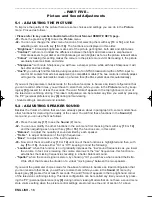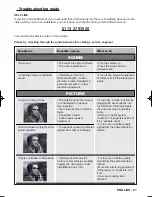
- Tuning tips
Picture interference from other equipment
If you have used the aerial lead to connect a video recorder, satellite receiver or other piece of equip-
ment, switch the equipment on one piece at a time and check the picture on all your programmes. The
pieces of equipment that are not switched on must be on stand-by. If any of your programmes have
wavy lines on the picture when the equipment is switched on you will have to change the output fre-
quency of the equipment. Please read the instruction book for the equipment to find out how to do this.
Change the output frequency a little at a time (or in 8MHz steps) and keep checking all your pro-
grammes.
When there are no wavy lines (or other interference) on any of the pictures, re-tune the programme
number that you have chosen for your equipment (see 'Tuning in other equipment or programmes man-
ually’). Do the same for each piece of equipment, but after you’ve finished with each one, leave it
switched on while you check the next piece of equipment.
Continue until you have all the pieces of equipment working together without interfering with each
other. If you cannot get rid of the interference you may have to connect the equipment with a scart
cable (see ‘Connecting the equipment to the television sockets’ on page 17 - 18).
Tuning in older equipment
Sometimes it is easier to tune in older equipment, such as a video recorder or a
satellite receiver, by tuning the equipment to the television. This is especially true if it
is producing a non-standard output frequency. Older equipment typically has a simple
output signal modulator with an adjustment screw on the back: this illustration shows
a typical adjuster. Video game consoles are usually set to broadcast channel 36.
1 - Switch on the equipment so it will produce a recognisable picture (read the user
instructions for the equipment if you need to).
2 - Follow ‘Manually finding and storing the stations’, page 11 - 14.
3 - You might already find a good picture and sound from the equipment. If you do not have good pic-
ture and sound find the adjustment screw illustrated above and using a small flat-bladed screwdriver
carefully turn the screw until the picture and sound are tuned in properly.
4 - Change to a different programme number and back again. If the picture or sound go off tune, re-
adjust the screw (above) very slightly in the direction which you find improves things and try again. Or
you can resort to ‘Fine tuning’ in step 8, page 14.
––––––––––––––––––––––––––––––––––––––––––––––––––––––––––––––––––––––––––––––––––
Where we refer to channel 36 above, please note the vast majority of older equipment uses channel
36 but a few use channel 52 or another. If in doubt you can manually step through channels 21 to 69
by repeatedly pressing key [15] in ‘Manually finding and storing the stations’, step 7, page 14. It might
help if you disconnect the television roof aerial cable while you are doing this, so any signal you find
must be from the equipment.
––––––––––––––––––––––––––––––––––––––––––––––––––––––––––––––––––––––––––––––––––
ENGLISH - 23
CH ADJ
Testo del man. SWING (UK) 14-10-2002 9:41 Pagina 23


































